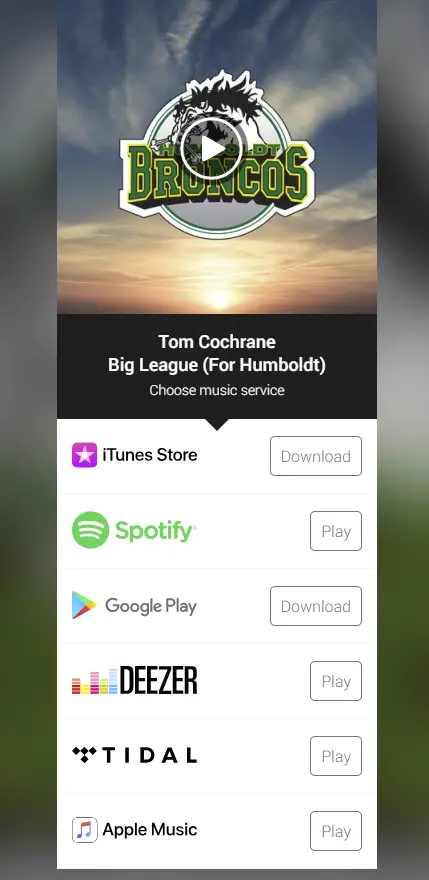
What makes a good driving song? Let’s explore that with Tom Cochrane.
[This a column I contributed to the Toronto Star Wheels section this weekend. -AC]
It may seem like a distant memory, but there is no better feeling than hitting the pavement and setting off on a road trip — whether aimlessly wandering through the province’s back-roads or an epic cross-country drive.
As you wait to be able to travel again, you can still capture that feeling of being on the road by listening to your favourite driving songs. If road trip songs are defined as anything that sounds good with the volume turned up and the windows rolled down, then your playlist can be filled with anything you like listening to.
To be considered a classic, however, there are some key parameters a song needs to meet. Research by London Metropolitan University in England encourages drivers to stick with songs within the range of the human heartbeat, which is 60 to 80 beats per minute (BPM). Its research would have us believe the perfect road song is Elton John’s “Tiny Dancer” at 72 BPM, and that “Under the Bridge” by the Red Hot Chili Peppers is too, well, peppy, at 84 BPM.
Most people prefer something less attuned to keeping you calm and relaxed, and more, you know, driving. A song that enhances the feeling of speed and forward movement, and ensures you get chills when the first few notes play. When it comes to Canadian classics worthy of epic status, nothing beats Tom Cochrane’s “Life is a Highway” (at a spirited 103 BPM).
“I wrote it as a metaphor after a trip through six war-torn countries in Africa,” Cochrane said. “I wrote it as therapy, a way to stay positive. It’s about the journey of life and how you have to keep moving forward.”
BONUS: More driving tuneage.
Everyone who sits behind the wheel of a vehicle has their favourite driving songs. Listening to music is a perfect way to make any journey—even a commute in heavy traffic—more enjoyable.
This wasn’t always the case. Back in 1930, just as radios were beginning to appear in cars, George A. Parker, the Massachusetts registrar for motor vehicles, was determined to ban radios in all automobiles, insisting they were highly distracting.
Had he not been shouted down by the state’s automobile enthusiasts—several hundred showed up at his office to complain in late February of that year—there’s a chance that a Massachusetts ban would have spread to other parts of the U.S. St. Louis was apparently anxious to do something similar had the law passed in Boston.
He was also taken to task by the head of the Radio Manufacturers Institute who pointed out that radio is not in “the class with the back seat drier with his or her irritating remarks, nor can a radio set carry on an argument with the driver.” Parker gave up and decided that prosecuting drunk drivers was a better idea.
Hey, it was the prohibition era. Some people were up for banning anything.
I also remember my poor Uncle Eddie’s ultra-bare-bones government-issue 1973 Ford Maverick. Even though his job with the Forestry Branch required him to drive hundreds of miles all over Manitoba, his bosses believed that even a basic AM radio was a luxury that needed to be denied. There was nothing but a plastic cover in the dash where the radio should be. I guess he was supposed to be thinking about trees and bear traps the entire time he was on the road.
Today, though, we’re much more enlightened. According to people paid to research such things, well over 90% of us listen to music in the car. Most of the time (about 60%) the radio will do, but there are those occasions (about 15%) that call for a special playlist to set the proper driving vibe.
And any kind of music will do. If we define driving songs as anything that sounds good with the radio up and the windows down, your playlist can be filled up with anything you like as long as it makes the trip more enjoyable. It’s all about personal taste.
But there are still some parameters. It may seem obvious, but any driving playlist should consist of songs that are tried-and-true favourites, a personal greatest hits collection. Each track should among the best songs you’ve ever heard. If you don’t get chills with the first few notes, it’s not right. A word of warning, though. Songs that are too fast can push you to subconsciously break the speed limit or (as Esso pointed out in a 1958 study warning of the dangers of driving while listening to rock’n’roll) cause your foot to jiggle on the go-fast pedal, reducing gas mileage.
Most people prefer something less soporific and more, you know, driving, something with a pulse that enhances the feeling of speed and forward movement. Safely and responsibly, of course.
A couple of other hints: Pay attention to the capabilities of your audio system. If it’s capable of producing deep bass, don’t shy a way from turning your car into a thump machine. Your neighbours will appreciate it. Honest.
Don’t get hung up on looking for songs that mention cars, driving, the open road or anything similar. You’re looking for mood more than anything.
And finally, don’t be afraid to ask for help. Search for “driving” on Spotify and hundreds of playlists will appear. There’s bound to be one right for you.


